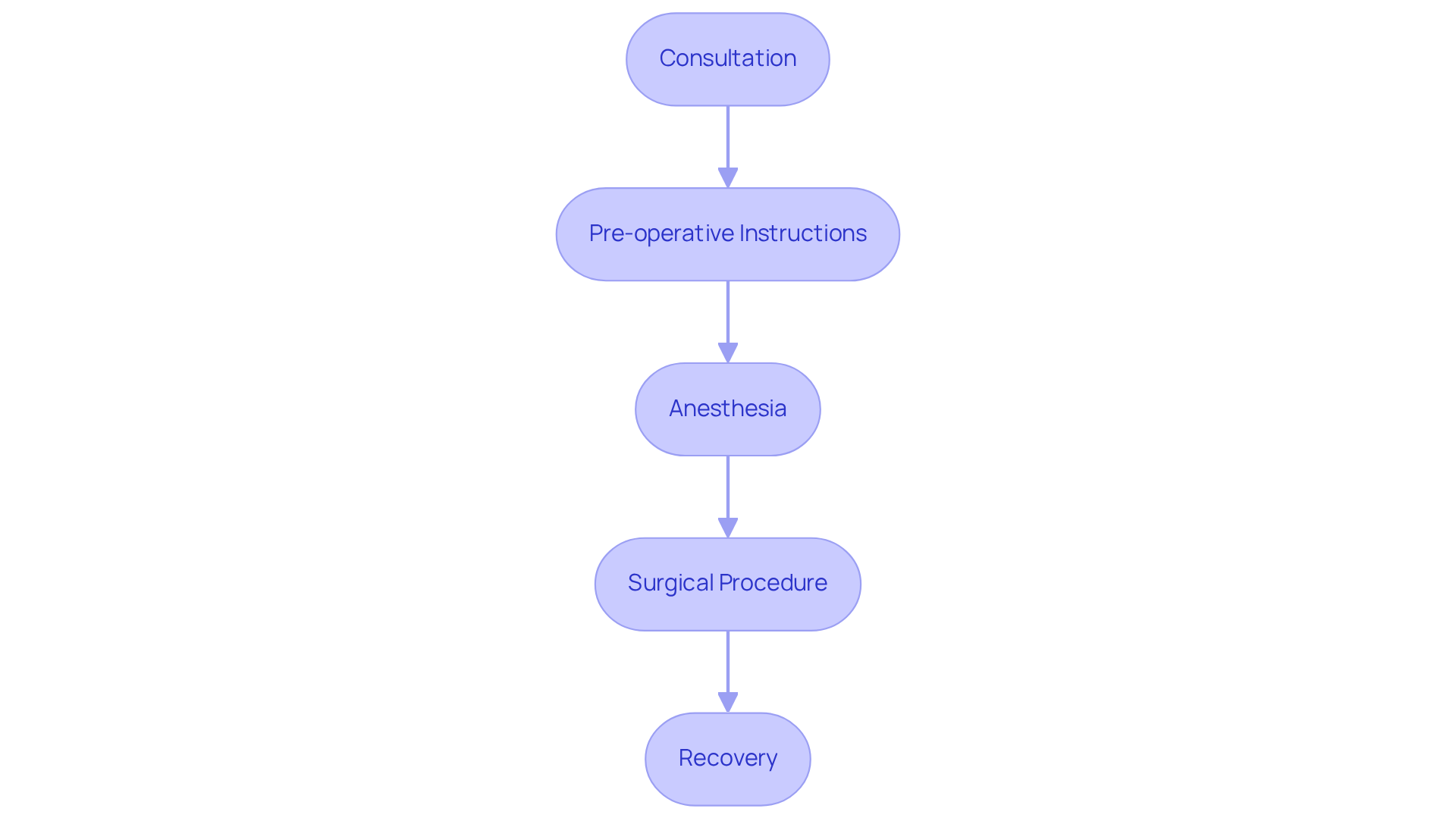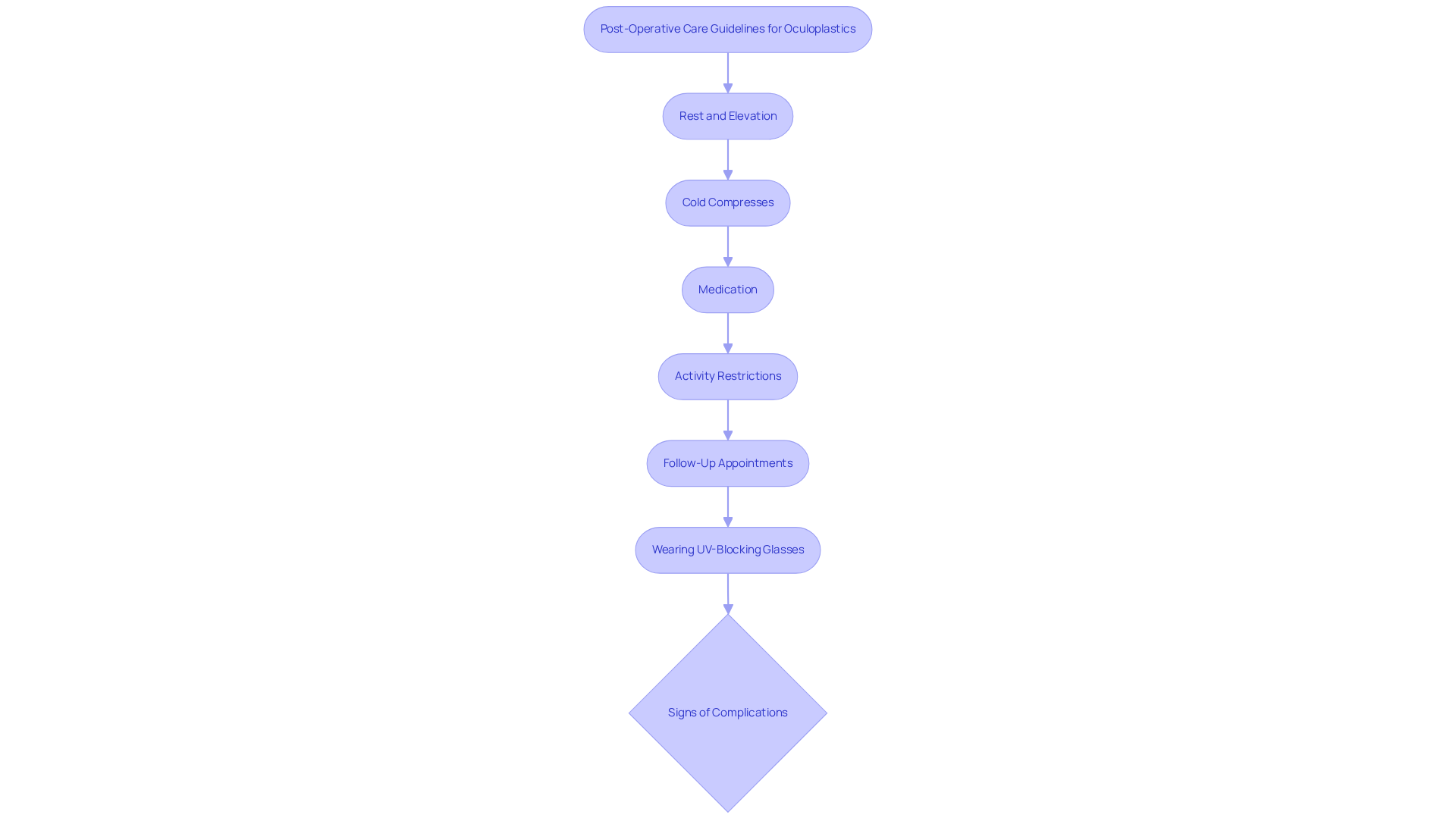Posted by: Northwest Eye in General on August 26, 2025
Overview
Oculoplastics plays a vital role for cataract patients, addressing both functional and aesthetic concerns related to the eyelids and surrounding facial structures. These aspects can significantly impact vision and overall quality of life. We understand that navigating these issues can be challenging, and it’s important to recognize how they affect your daily experiences.
This article emphasizes that understanding oculoplastic conditions and procedures is essential for improving surgical outcomes and enhancing patient satisfaction. For those experiencing symptoms like ptosis or chronic tearing, we want you to know that additional interventions may be necessary alongside cataract surgery. It’s common to feel overwhelmed by these possibilities, but rest assured, we are here to help you through this process.
Introduction
Oculoplastics plays a pivotal role in enhancing both vision and aesthetics for patients, especially those dealing with cataracts. We understand that this can be a challenging time, filled with concerns about both your health and appearance. This specialized branch of ophthalmology addresses a range of issues, from eyelid misalignment to tear duct problems, which can significantly impact one’s quality of life.
However, it’s common for patients to remain unaware of the critical link between oculoplastic procedures and their overall eye health. Understanding these treatments can not only alleviate physical discomfort but also boost self-esteem and satisfaction in post-surgery outcomes.
We are here to help you through this process, ensuring you feel informed and supported every step of the way.
Define Oculoplastics: Scope and Importance
Oculoplastics is a specialized field in ophthalmology that concentrates on both surgical and non-surgical techniques related to the eyelids, tear ducts, and adjacent facial structures. We understand that can affect both your vision and self-esteem. This discipline is essential for addressing functional issues, such as eyelid misalignment or tear drainage problems, as well as aesthetic concerns, including sagging eyelids (ptosis) or facial asymmetry.
It’s common to feel worried about a drooping eyelid, especially since it can interfere with vision and may signal various conditions, such as thyroid eye disease and amblyopia. For individuals with cataracts, understanding the significance of oculoplastics is crucial, as many may need additional procedures to improve their vision and appearance after surgery. The integration of oculoplastics techniques can significantly improve surgical outcomes and patient satisfaction.
If you are experiencing symptoms like sagging eyelids, we encourage you to seek professional medical assistance. Exploring treatment options, including blepharoplasty, can enhance both function and appearance. Remember, you are not alone in this journey; we are here to help you through this process.
Explore Common Oculoplastic Conditions and Treatments
Understanding common oculoplastics conditions is the first step towards finding relief, as they can be concerning. Here are some important conditions to be aware of:
- Ptosis: This condition involves the drooping of the upper lid, which can obstruct vision and lead to complications such as astigmatism and amblyopia if left untreated. We understand that this can be distressing, but is often required to elevate the eyelid region, and it boasts a high success rate in most instances.
- Ectropion and Entropion: These conditions occur when the skin folds around the eyes turn outward or inward, respectively, causing discomfort and potential vision problems. Surgical repair is usually necessary to restore proper function of the eye’s lid, and we are here to support you through this process.
- Chronic Tearing (Epiphora): Often resulting from blocked tear ducts, this condition can be effectively treated through surgical procedures that restore proper drainage. This can alleviate discomfort and improve your eye health significantly.
- Dermatochalasis: Excess skin on the upper and lower eyelids can hinder vision. This condition is typically treated through blepharoplasty, which eliminates the surplus skin, enhancing both function and appearance.
- Orbital Fractures: Injuries to the eye socket may necessitate reconstructive surgery to restore both function and aesthetic appearance. We recognize how challenging this can be and are committed to guiding you through every step.
Grasping these conditions is essential for individuals with lens opacity, as they may encounter overlapping symptoms or complications that require intervention in oculoplastics. For example, surgical procedures for ptosis have demonstrated a favorable outlook, with numerous individuals experiencing considerable enhancement in their eyelid position and vision after the operation. Oculoplastics surgeons emphasize the importance of addressing ptosis, particularly in patients with lens opacity, to prevent further vision deterioration. Case studies indicate that timely intervention can lead to successful outcomes, enhancing the quality of life for those affected.
Treatment alternatives for ptosis in lens opacity patients may involve surgical methods to tighten the levator muscle, with or without skin incision, based on the severity of the condition. Additionally, some adults may benefit from oxymetazoline eye drops, which target the levator muscle to achieve a wider eyelid opening. Regular consultations with eye care specialists are essential for monitoring and managing these conditions effectively. Remember, we are here to help you through this process, ensuring you receive the care and support you deserve.

Understand Oculoplastic Procedures: What to Expect
Oculoplastics procedures involve various surgical techniques designed for particular eye ailments, including lens opacities. We understand that navigating cataract surgery can feel overwhelming. Here’s what cataract patients can generally expect at Northwest Eye:
- Consultation: During your visit, our oculoplastic surgeon will conduct a detailed evaluation covering your symptoms, medical history, and potential treatment options. This ensures a personalized approach to your care. We will discuss the best tailored to your lifestyle, emphasizing the importance of selecting the right type of lens implant for optimal visual outcomes.
- Pre-operative Instructions: It’s common to feel uncertain about what to do before surgery. Patients are typically advised to avoid certain medications, cease smoking, and arrange for post-operative assistance. These steps are crucial for minimizing risks and promoting optimal recovery.
- Anesthesia: Depending on the intricacy of your operation, surgeries may be conducted under local anesthesia with sedation or general anesthesia, allowing for a comfortable experience.
- Surgical Procedure: The details of the surgery will differ; for example, eye lens surgery is an outpatient procedure that can greatly enhance your vision. The surgery usually lasts about one to two hours, focusing on enhancing both function and aesthetics. Our advanced refractive eye surgery packages are designed to address specific vision outcomes, ensuring a tailored experience.
- Recovery: After surgery, it’s normal to experience some swelling and bruising, which generally resolve within a few weeks. You may feel some discomfort, and we will prescribe appropriate pain medications to help manage this. Most individuals can return to regular activities within a few days to a week following surgery. Follow-up appointments are essential for monitoring your healing and addressing any concerns, as they play a critical role in ensuring a smooth recovery.
Grasping these steps can greatly reduce anxiety for individuals undergoing cataract surgery. We are here to help you through this process, equipping you with the information necessary to confidently navigate your oculoplastics treatments.

Navigate Post-Operative Care and Recovery in Oculoplastics
Post-operative care is essential for a smooth recovery after surgery involving oculoplastics, including treatments such as the Light Adjustable Lens (LAL). We understand that this can be a challenging time, so here are some key guidelines to help you through your recovery:
- Rest and Elevation: Keeping your head elevated, especially during sleep, is vital to minimize swelling and promote healing. We know how important comfort is during this time.
- Cold Compresses: Applying cold compresses for the first 48 hours can significantly reduce swelling and discomfort. This simple step helps constrict blood vessels and minimizes bleeding, making your recovery more comfortable.
- Medication: Adhering to your prescribed medication regimen, including pain relievers and antibiotics, is essential. This will help manage your pain effectively and prevent infection, allowing you to focus on healing.
- Activity Restrictions: It’s important to avoid strenuous activities, heavy lifting, and bending over for at least two weeks post-surgery. This helps mitigate the risk of complications. However, light exercises like walking can typically be resumed a few days after surgery, which can be a great way to stay active.
- Follow-Up Appointments: Attending all scheduled follow-ups is critical for monitoring your healing progress and addressing any concerns. These visits provide reassurance and peace of mind regarding your recovery process. For LAL individuals, follow-ups are especially crucial for light adjustments throughout the healing period.
- Wearing UV-Blocking Glasses: Protecting your lens during the healing process is essential, so after surgery is highly recommended.
- Signs of Complications: Please remain vigilant for signs of infection or unusual symptoms, such as excessive swelling or persistent pain. If you notice these, contact your surgeon right away. Reporting any significant pain or unusual symptoms is crucial for comprehensive care. Irritated eyes can also be a concern post-surgery, with symptoms potentially arising from allergies or infections, so awareness is key.
By diligently following these guidelines, you can enhance your oculoplastics recovery experience and achieve optimal outcomes from your procedures. Remember, we are here to help you through this process.

Conclusion
Understanding oculoplastics is vital for cataract patients, as it encompasses both the functional and aesthetic aspects of eye care. We understand that this specialized field addresses various conditions around the eyelids and tear ducts, significantly impacting not only vision but also self-esteem. By recognizing the importance of oculoplastics, you can make informed decisions about your treatment options, ensuring you receive comprehensive care tailored to your needs.
Key insights highlight common oculoplastic conditions such as:
- Ptosis
- Ectropion
- Chronic tearing
along with the surgical procedures available to address these issues. It’s common to feel anxious about these conditions, but timely intervention can lead to successful outcomes, enhancing both vision and quality of life. Additionally, understanding the steps involved in oculoplastic procedures and post-operative care can alleviate anxiety, allowing you to navigate your recovery with confidence.
Ultimately, the significance of oculoplastics in your journey as a cataract patient cannot be overstated. Seeking professional guidance and exploring available treatment options can lead to improved functional and aesthetic results. If you are experiencing symptoms related to oculoplastic conditions, we encourage you to consult with eye care specialists. You deserve the necessary support and care throughout your journey. Taking proactive steps towards eye health can pave the way for a brighter, clearer future.
Frequently Asked Questions
What is oculoplastics?
Oculoplastics is a specialized field in ophthalmology that focuses on surgical and non-surgical techniques related to the eyelids, tear ducts, and adjacent facial structures.
Why is oculoplastics important?
Oculoplastics is important for addressing both functional issues, such as eyelid misalignment and tear drainage problems, as well as aesthetic concerns like sagging eyelids (ptosis) and facial asymmetry.
What are some common concerns related to oculoplastics?
Common concerns include drooping eyelids, which can interfere with vision and may indicate conditions such as thyroid eye disease and amblyopia.
How does oculoplastics relate to cataract surgery?
For individuals with cataracts, understanding oculoplastics is crucial as they may need additional procedures to improve both their vision and appearance after cataract surgery.
What symptoms might indicate the need for oculoplastic treatment?
Symptoms that may indicate the need for oculoplastic treatment include sagging eyelids and other functional or aesthetic concerns related to the eyelids and surrounding areas.
What treatment options are available in oculoplastics?
Treatment options in oculoplastics include procedures such as blepharoplasty, which can enhance both the function and appearance of the eyelids.
What should I do if I am experiencing symptoms related to oculoplastics?
If you are experiencing symptoms like sagging eyelids, it is encouraged to seek professional medical assistance to explore treatment options.






